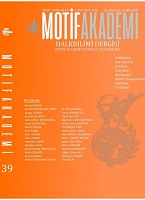KOKOSHNIK: A FEMALE HEADDRESS IN THE TRIANGLE OF TRADITION, TALISMAN, AND GENDER ROLES
KOKOSHNIK: A FEMALE HEADDRESS IN THE TRIANGLE OF TRADITION, TALISMAN, AND GENDER ROLES
Author(s): Duygu ÖzakınSubject(s): Gender Studies, Customs / Folklore, Cultural Anthropology / Ethnology, Culture and social structure
Published by: Motif Halk Oyunları Eğitim ve Öğretim Vakfı
Keywords: Kokoshnik; women’s headdress; material culture; gender roles; Russian ethnographers;
Summary/Abstract: Folk costumes, which are among the elements of material culture and concrete indicators of the lifestyle of individuals, carry the reflections of the life shaping beliefs from generation to generation. Because of these aspects, they are the target of Westernization movements while being embraced by a certain group as a symbol of national values. Kokoshnik, a traditional headdress worn by women, goes through a similar transformation process from the time it is first used to the date when it is pushed out of daily life due to ideological concerns. The headdress is named after the Old East Slavic word kokosh meaning “chicken”, because of its form similar to that of poultry’s comb. The tailors with specialized training in sewing this flamboyant headdress adorned with precious stones and embroidery, are called kokoshnitsa, which also comes from the same root. In this review article, it is aimed to contribute to the international literature, which has been determined to be quite limited in terms of content and quantity. Studies that deal with kokoshnik both as a traditional headdress and an indicator of women’s marital status and social position, are evaluated through comparative method. This study, which compares the etymological studies of Russian ethnographers, folklorists, art critics, and linguists such as G. S. Maslova, N. I. GagenTorn, D. K. Zelenin, V. V. Stasov, V. I. Dal’ and S. I. Ozhegov on kokoshnik, also includes current research. In all these studies, it is revealed that two basic tendencies gain importance: In early studies, the emergence of the headdress due to the religious superstition about uncovered hair brings bad luck is discussed and its function as a talisman is emphasized. The values symbolized by kokoshnik in the social status of women and in distribution of responsibilities within the family are also examined in the light of ethnographic data. However, in current studies, a critical perspective draws attention that the kokoshnik is reflected as an accessory that symbolizes traditional costumes in a stereotypical way, and thus, the Russian clothing culture, which has a very rich history indeed, is reduced to a monotonic image.
Journal: Motif Akademi Halkbilimi Dergisi
- Issue Year: 15/2022
- Issue No: 39
- Page Range: 691-707
- Page Count: 17
- Language: English

